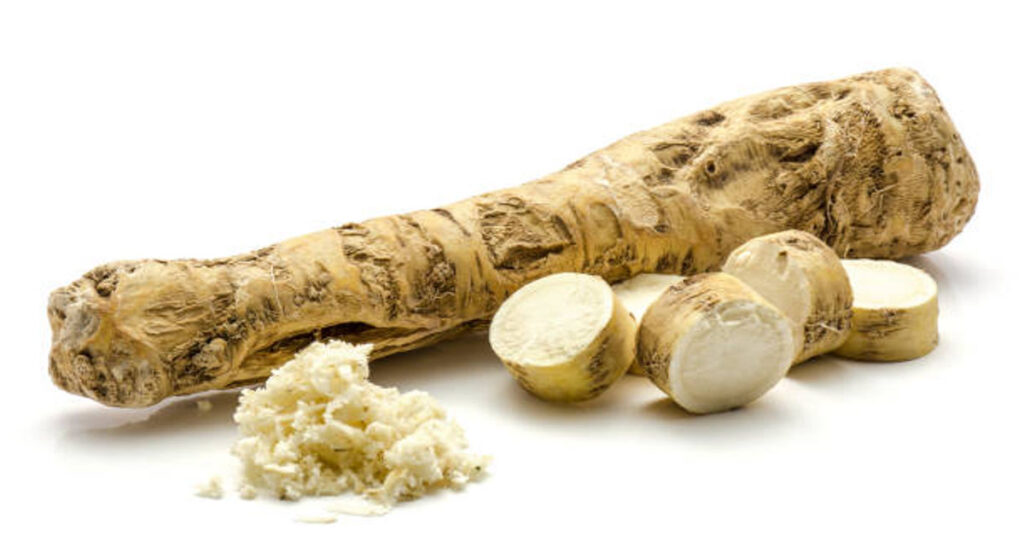The plant world is filled with natural treasures that offer both culinary delight and therapeutic value. Among these, Meerrettich, known in English as horseradish, stands out as a pungent, spicy root that has traveled centuries through European kitchens and medicine cabinets alike. This fascinating plant, with its sharp taste and unmistakable aroma, has been an integral part of traditional diets and folk remedies, particularly in German-speaking countries where it has long been celebrated for its flavor and healing power.
This article offers a comprehensive exploration of Meerrettich — its origins, botanical features, nutritional composition, health benefits, culinary applications, cultivation methods, and cultural significance. It will also provide an in-depth analysis of how this humble root became a global symbol of strength, health, and vitality.
1. The Origin and Etymology of Meerrettich
The name “Meerrettich” comes from the German language. It literally translates to “sea radish” (“Meer” meaning “sea” and “Rettich” meaning “radish”), though it does not actually grow near the sea. The word likely originated because the plant spread widely across European coastal regions through trade routes.
Meerrettich belongs to the Brassicaceae family, the same family as mustard, cabbage, broccoli, and wasabi. Botanically, its scientific name is Armoracia rusticana. The plant is believed to have originated in southeastern Europe or western Asia, from where it spread across the continent, gaining popularity in regions such as Germany, Austria, Poland, and the Czech Republic.
Throughout history, Meerrettich has been valued not only as a condiment but also as a symbol of strength and healing. Ancient Greeks and Romans regarded it as a medicinal plant capable of curing respiratory illnesses and digestive issues. Medieval Europeans used it as a natural antibiotic, centuries before the discovery of penicillin.
2. Botanical Characteristics of Meerrettich
Meerrettich is a perennial root plant that grows up to 1.5 meters tall under favorable conditions. The edible part is the thick, white, fleshy root, which stores most of the nutrients and essential oils responsible for its characteristic heat and aroma.
Table: Key Botanical Features of Meerrettich
| Characteristic | Description |
|---|---|
| Scientific Name | Armoracia rusticana |
| Plant Family | Brassicaceae (Mustard family) |
| Type | Perennial herb |
| Edible Part | Root |
| Color | White to cream |
| Flavor Profile | Pungent, sharp, and spicy |
| Climate Preference | Cool to temperate regions |
| Soil Requirement | Loamy, moist, well-drained soil |
| Harvest Period | Late autumn to early spring |
The root of the Meerrettich plant contains glucosinolates — sulfur-containing compounds that, when crushed, release allyl isothiocyanate, the chemical responsible for its sharp, tear-inducing aroma. Interestingly, the root itself has little odor until it is grated or cut, when enzymes activate and release its volatile oils.
3. Nutritional Composition of Meerrettich
Meerrettich is not just about its fiery taste; it is also a nutritional powerhouse. It contains vitamins, minerals, enzymes, and natural compounds that promote health and vitality.
Table: Nutritional Composition per 100g of Fresh Meerrettich
| Nutrient | Amount | Health Role |
|---|---|---|
| Calories | 48 kcal | Provides energy |
| Carbohydrates | 11.3 g | Natural energy source |
| Protein | 1.2 g | Tissue repair and enzyme production |
| Fat | 0.7 g | Very low-fat content |
| Dietary Fiber | 3.3 g | Aids digestion |
| Vitamin C | 24.9 mg | Boosts immunity and collagen production |
| Folate (B9) | 57 µg | Supports cell regeneration |
| Calcium | 56 mg | Strengthens bones |
| Potassium | 246 mg | Regulates blood pressure |
| Magnesium | 27 mg | Supports muscle function |
| Iron | 0.4 mg | Prevents anemia |
| Glucosinolates | Variable | Antioxidant and anti-inflammatory compounds |
This combination of nutrients makes Meerrettich a functional food — one that not only nourishes but also heals.
4. Health Benefits of Meerrettich
For centuries, Meerrettich has been considered both food and medicine. The strong, spicy root possesses antibacterial, antioxidant, and detoxifying properties, offering a range of benefits that modern science is beginning to confirm.
4.1 Immune System Support
Meerrettich is rich in vitamin C, one of the most essential nutrients for immune function. Regular consumption helps the body defend against infections, especially in colder months. The natural compounds also stimulate the production of white blood cells and enhance the body’s resistance to bacteria and viruses.
4.2 Respiratory Relief
Its pungent vapors act as a natural decongestant, clearing sinuses and respiratory passages. Traditionally, Meerrettich was used to relieve symptoms of colds, bronchitis, and sinusitis by inhaling its freshly grated aroma or consuming it with honey.
4.3 Digestive Stimulation
Meerrettich stimulates digestive enzymes and bile production, promoting efficient digestion. It helps the stomach process heavy foods, prevents bloating, and improves appetite — which is why it is often served alongside fatty dishes like sausages or roast meats.
4.4 Antibacterial and Antiviral Properties
The allyl isothiocyanate compound released when Meerrettich is grated acts as a natural antibiotic, effective against harmful bacteria such as E. coli and Staphylococcus aureus. This makes it a valuable food for maintaining gut health.
4.5 Anti-inflammatory Effects
The root’s active compounds help reduce inflammation in the body, making it useful for conditions like arthritis, muscle pain, and general fatigue. In folk medicine, compresses made from grated Meerrettich were applied to sore joints for relief.
4.6 Detoxification and Liver Support
Meerrettich aids the liver in detoxifying harmful substances by stimulating enzyme activity. It also promotes kidney function, encouraging natural elimination of toxins through urine.
4.7 Heart Health
Potassium and antioxidants in Meerrettich help regulate blood pressure, prevent plaque formation in arteries, and maintain healthy circulation.
4.8 Cancer Prevention Potential
Glucosinolates and isothiocyanates found in Meerrettich have been shown in studies to inhibit the growth of certain cancer cells by neutralizing carcinogens and supporting DNA repair.
5. Culinary Uses of Meerrettich
Meerrettich’s culinary versatility makes it a beloved ingredient in European cuisine. It adds a sharp, spicy edge to foods and enhances flavor profiles when used in moderation.
5.1 Traditional German Uses
In Germany, Meerrettich is served with:
- Smoked salmon or trout (Forelle mit Meerrettich)
- Boiled beef (Tafelspitz mit Meerrettichsoße)
- Cold cuts and sausages
- Potato dishes and soups
5.2 Fresh vs. Prepared Meerrettich
The root can be used:
- Freshly grated — for intense flavor.
- Creamed or preserved — mixed with vinegar or cream for a milder taste.
- In sauces — to accompany meats and fish.
5.3 International Culinary Variations
Different countries have developed their own versions of Meerrettich-based condiments:
- Poland: “Chrzan,” often served at Easter with boiled eggs.
- Czech Republic: “Křen,” a staple condiment for roasted meats.
- United States: Creamed horseradish used in roast beef sandwiches.
- Japan: A related plant (wasabi) serves a similar purpose with sushi.
6. Cultivation of Meerrettich
Growing Meerrettich requires patience, proper soil, and cool climates. It thrives in temperate regions and can survive light frosts.
Steps for Cultivation:
- Soil Preparation: Deep, well-drained soil is essential. Organic compost is mixed before planting.
- Planting: Root cuttings (called “sets”) are planted in early spring at a depth of 5–10 cm.
- Watering: Regular but not excessive watering ensures steady growth.
- Weeding: The area should be kept free from competing plants.
- Harvesting: Typically done in late autumn when roots are mature, thick, and aromatic.
Table: Optimal Growing Conditions
| Parameter | Ideal Condition |
|---|---|
| Temperature | 10–18°C |
| Sunlight | Partial to full sunlight |
| Soil Type | Loamy and well-drained |
| Soil pH | 6.0–7.5 |
| Watering | Moderate, consistent moisture |
| Harvest Time | After 6–9 months |
After harvesting, roots can be stored in a cool, dark place for several months.
7. Preservation and Storage of Meerrettich
Fresh Meerrettich loses its potency quickly after grating. To preserve flavor:
- Store the root unpeeled in the refrigerator wrapped in a damp cloth.
- Grated Meerrettich can be mixed with vinegar to stabilize the pungent compounds.
- It can also be frozen in airtight containers, though slight loss of aroma occurs.
Many households prepare Meerrettich paste — a blend of grated root, vinegar, sugar, and salt — that can last several weeks when refrigerated.
8. Traditional and Medicinal Applications
Throughout history, Meerrettich has played a major role in natural medicine. Its antimicrobial and stimulating qualities made it valuable for many ailments.
Folk Remedies:
- Cold and flu relief: Grated root infused in hot water or vinegar, inhaled as steam.
- Digestive tonic: A small amount before meals stimulates appetite.
- Pain relief compress: Applied externally for muscle and joint discomfort.
- Diuretic use: Consumed as juice to promote kidney cleansing.
In medieval monasteries, monks used Meerrettich as part of herbal treatments to strengthen the body against infections, particularly during winter months.
9. Side Effects and Precautions
While generally safe, Meerrettich should be used in moderation. Its intense compounds can cause irritation if overconsumed.
Possible Effects of Excessive Consumption:
| Affected Area | Potential Effect |
|---|---|
| Mouth & Throat | Burning or irritation |
| Stomach | Acidity, upset stomach |
| Skin | Redness if applied directly |
| Eyes | Watering or discomfort |
Precaution:
Pregnant or breastfeeding women, and individuals with kidney disorders, should consult a healthcare provider before using Meerrettich medicinally.
10. Meerrettich in Modern Health and Nutrition Trends
In recent years, Meerrettich has experienced a resurgence as a natural health booster. Nutritionists now view it as part of the “functional food movement,” emphasizing foods that deliver therapeutic benefits beyond basic nutrition.
It is used in:
- Detox diets for liver and kidney support.
- Natural cold remedies for respiratory cleansing.
- Weight management diets due to its metabolism-boosting effect.
Its low calorie and high antioxidant content make it ideal for health-conscious consumers seeking flavorful yet wholesome condiments.
11. Environmental and Economic Importance
Meerrettich cultivation supports local farming economies in Germany, Austria, and Eastern Europe. Regions like Franconia (Franken) in Germany are famous for cultivating high-quality Meerrettich, recognized with Protected Geographical Indication (PGI) status.
Sustainable farming of Meerrettich also benefits the environment:
- Minimal pesticide use due to natural pest resistance.
- Deep root systems improve soil aeration.
- Acts as a rotation crop, preventing soil exhaustion.
12. Meerrettich vs. Wasabi: A Common Confusion
Though both Meerrettich and wasabi belong to the Brassicaceae family, they differ significantly.
| Feature | Meerrettich (Horseradish) | Wasabi (Japanese Horseradish) |
|---|---|---|
| Scientific Name | Armoracia rusticana | Wasabia japonica |
| Color | White or cream | Green |
| Taste | Sharp, dry heat | Mild, aromatic heat |
| Cultivation Region | Europe | Japan |
| Availability | Widely available | Rare, expensive |
| Usage | Condiments, sauces | Sushi and Japanese cuisine |
Most “wasabi” served globally actually uses Meerrettich dyed green due to wasabi’s scarcity.
13. The Cultural Symbolism of Meerrettich
Meerrettich symbolizes strength, endurance, and purity in European folklore. In some traditions, it was believed to ward off evil spirits or serve as a charm against illness. During festivals, particularly in Bavaria and Austria, Meerrettich is still used in ceremonial dishes symbolizing health and vitality.
In Jewish Passover traditions, horseradish is one of the “bitter herbs” symbolizing the suffering of ancestors — linking it deeply to historical and cultural memory.
14. The Future of Meerrettich
As global cuisine evolves, Meerrettich continues to inspire innovation. Chefs are experimenting with it in:
- Salad dressings and fusion sauces.
- Modern condiments like horseradish aioli.
- Plant-based meat alternatives, where it adds “bite.”
- Fermented products for enhanced probiotic value.
Sustainably cultivated Meerrettich is also finding a place in natural pharmaceuticals, cosmetics, and herbal supplements due to its antimicrobial nature.
15. Conclusion
Meerrettich is far more than a spicy root. It is a living bridge between food, health, and tradition — a plant that has nourished bodies and inspired cultures for centuries. Its medicinal history, nutritional strength, and culinary versatility have made it an enduring part of human heritage.
In a world increasingly turning toward natural remedies and wholesome eating, Meerrettich stands as a symbol of balance — combining ancient wisdom with modern science, flavor with function, and tradition with innovation. Whether enjoyed as a condiment, grown in home gardens, or used in herbal therapy, this remarkable root continues to remind us of nature’s power to heal, flavor, and sustain.
Frequently Asked Questions (FAQs)
1. What is Meerrettich?
Meerrettich, known as horseradish in English, is a pungent root vegetable used both as a spicy condiment and a natural medicine.
2. What are the main health benefits of Meerrettich?
It supports the immune system, aids digestion, acts as an antibacterial agent, improves circulation, and helps detoxify the body.
3. How is Meerrettich used in cooking?
It’s grated fresh, added to sauces, or blended with cream or vinegar to accompany meats, fish, and vegetables.
4. Can Meerrettich be grown at home?
Yes. It’s easy to cultivate in cool climates with deep, loamy soil and can be harvested after 6–9 months.
5. Is Meerrettich the same as wasabi?
No. While related, wasabi is a different species native to Japan. Most commercial wasabi is actually made from Meerrettich.







